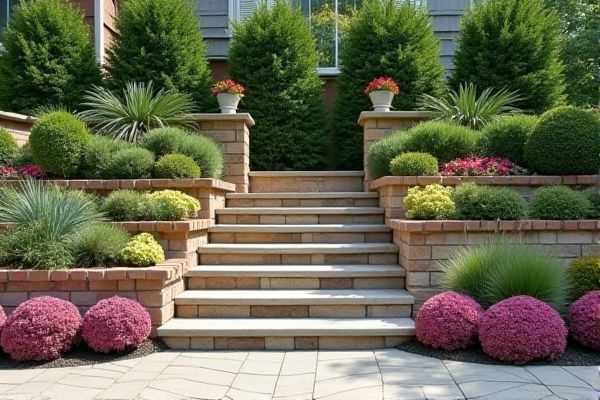
Retaining walls provide structural support to hold back soil on sloped landscapes, preventing erosion and creating level planting areas, while garden edging serves primarily as a decorative border to define garden beds and pathways. Understanding the differences in function and design will help you choose the best option for your outdoor space--explore the rest of the article to learn more.
Table of Comparison
| Feature | Retaining Wall | Garden Edging |
|---|---|---|
| Purpose | Supports and holds back soil on slopes | Defines garden beds and pathways, controls grass spread |
| Materials | Concrete, stone, brick, wood, gabion baskets | Plastic, metal, wood, stone, concrete |
| Height | Typically over 3 feet (1 meter) | Usually 4-12 inches (10-30 cm) |
| Structural Function | Load-bearing, prevents soil erosion | Decorative and defining, minimal structural support |
| Installation Complexity | Requires engineering, permits may be needed | Simple DIY installation |
| Cost | Higher due to materials and labor | Lower, affordable for most gardens |
| Lifespan | 20+ years with proper maintenance | 5-15 years depending on material |
| Common Uses | Terracing, soil retention on slopes, creating level garden areas | Border definition, weed control, aesthetic enhancement |
Understanding Retaining Walls and Garden Edging
Retaining walls are structural elements designed to hold back soil and prevent erosion, often built from concrete, stone, or timber, making them ideal for managing slopes and creating level garden spaces. Garden edging serves as a decorative and functional boundary, typically made from materials like metal, plastic, or brick, helping to define garden beds and prevent grass or weeds from spreading into flower areas. Understanding the distinct purposes and materials of retaining walls versus garden edging can help you choose the right solution to enhance both the aesthetics and functionality of your outdoor space.
Key Differences Between Retaining Walls and Garden Edging
Retaining walls serve to hold back soil and prevent erosion on sloped landscapes, typically constructed from sturdy materials like concrete, stone, or brick for structural support. Garden edging primarily defines garden beds and pathways, enhancing aesthetic appeal without the need for heavy-duty construction or significant soil retention. The key difference lies in function and durability: retaining walls manage substantial earth pressure, while garden edging provides decorative boundaries and minimal soil containment.
Functional Purposes: Support vs. Separation
Retaining walls provide critical structural support by holding back soil and preventing erosion, especially on slopes or uneven terrain, ensuring landscape stability. Garden edging primarily creates a clear separation between different garden areas, such as flower beds and lawns, enhancing aesthetic organization without bearing significant load. While retaining walls serve an engineering function to manage earth pressure, garden edging focuses on defining boundaries and maintaining clean garden lines.
Materials Used for Retaining Walls and Garden Edging
Retaining walls are commonly constructed using durable materials like concrete blocks, natural stone, brick, or timber, designed to hold back soil and withstand significant pressure. Garden edging typically utilizes lighter materials such as plastic, metal, stone, or wood to create clear boundaries between lawn, flower beds, and pathways without supporting heavy loads. Understanding the distinct materials used in your project ensures the right choice between a retaining wall's structural strength and garden edging's decorative function.
Installation Process: Complexity and Costs
Retaining wall installation involves excavation, foundation laying, and precise placement of heavy materials, leading to higher labor costs and requiring specialized equipment compared to garden edging. Garden edging typically uses simpler tools and materials like plastic, metal, or wood, resulting in a quicker and more affordable setup. The complexity of a retaining wall's structure demands professional skills, whereas garden edging can often be a DIY project with minimal expenses.
Aesthetic Impact in Landscape Design
Retaining walls create a bold, structural aesthetic by adding height, texture, and depth to landscapes, often serving as focal points that define garden spaces. Garden edging offers subtle visual boundaries that enhance garden beds and pathways, maintaining a neat and cohesive appearance without overwhelming the design. Both elements contribute uniquely to landscape aesthetics, with retaining walls emphasizing architectural form and garden edging promoting organized plant presentation.
Durability and Maintenance Requirements
Retaining walls offer superior durability, made from robust materials like concrete, stone, or brick, designed to withstand soil pressure and harsh weather conditions over long periods. Garden edging, while effective for defining garden borders, typically uses materials such as plastic, metal, or wood that may require more frequent replacement or treatment to prevent decay and rust. To ensure your outdoor space remains tidy and secure, prioritize retaining walls for long-term strength and minimal maintenance.
Best Applications for Retaining Walls
Retaining walls are best suited for managing soil erosion, creating level planting areas on sloped terrain, and supporting heavy loads in landscaping projects. Unlike garden edging, which primarily serves as a decorative boundary for flower beds or pathways, retaining walls provide structural support for significant height differences and water drainage control. Your outdoor space can benefit from retaining walls when you need durable solutions to stabilize soil and prevent landscape shifting.
Ideal Uses for Garden Edging
Garden edging is ideal for defining boundaries between flower beds, lawns, and pathways, preventing grass and weeds from encroaching on garden areas. It helps to create a clean, organized appearance while enhancing soil retention around plants without the need for extensive structural support. Your choice of garden edging can also support irrigation and mulch retention, promoting healthier plant growth with minimal maintenance.
How to Choose: Retaining Wall or Garden Edging?
Choosing between a retaining wall and garden edging depends on your landscaping needs and soil conditions. Retaining walls are ideal for managing significant soil erosion and creating terraced garden beds, providing structural support for slopes over 3 feet. Garden edging works best for defining garden boundaries, controlling grass spread, and offering low-profile aesthetic borders without heavy-duty soil retention.
 homyna.com
homyna.com